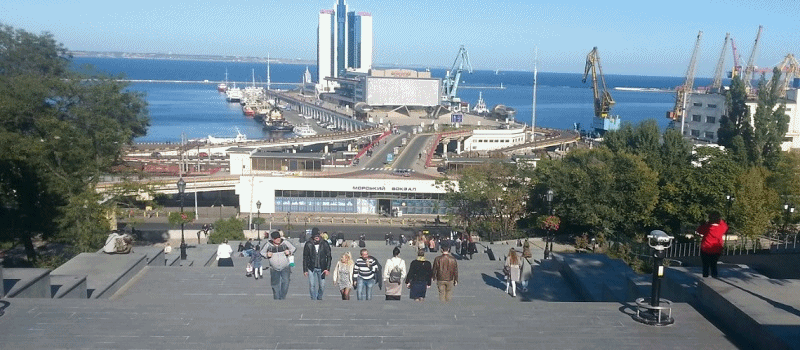The Potemkin Stairs, or Potemkin Steps as it is sometimes called, is a long and impressive stairway in Odessa, Ukraine. It connects Primorsky Boulevard with the Port of Odessa (Ukraine’s largest seaport) and is considered the formal entrance to the city when coming from the seaport.
Although the staircase is only around 142 meters long, thanks to the clever design, when you stand at the bottom and look up it appears to be a lot longer.
The secret to the optical illusion is actually pretty simple. The lowest step on the Potemkin Stairs is 21.7 meters wide. Each of the preceding steps is slightly narrower and the one at the top is just 12.5 meters wide. This creates the impression that the stairs are stretching off into the distance.
However, the way the stairway is designed is doubly clever because the stairs are interspaced with a series of landings. When you stand at the top and look down, all you can see is the landings. It’s impossible to see the steps at all. Yet, when you stand at the bottom of the Potemkin Stairs and look up, there is no way to know the landings are there. All you see is the stairs.
The Odessa stairs were originally known as the Boulevard Steps, the Giant Staircase, or the Richelieu Steps. However, in a case of life imitating art, the stairway was renamed in homage to a Soviet movie.
The Truth About the Potemkin Stairs Massacre
Easily one of the best-known symbols of Odessa, the Potemkin Stairs became famous all over the world thanks to a silent movie produced in 1925 by the Russian director Sergei Mikhailovich Eisenstein.
It’s called Battleship Potemkin and it presents a dramatized version of a real-life mutiny. It happened in June 1905, when the crew of the Russian battleship Potemkin rebelled against their officers in response to poor onboard conditions.
One of the most famous scenes in Battleship Potemkin is a massacre on the Odessa stairs. It shows the Tsar’s soldiers marching down the stairs, firing at the crowd that has gathered to support the Battleship Potemkin. Meanwhile, a separate division of mounted Cossacks is charging the crowd at the bottom of the stairs. It’s a bloodbath.
In 2012, the British Film Institute compiled a list of the 50 greatest movies of all time and Battleship Potemkin was placed at no. 11.
Fans of the movie may be surprised to learn that, although there was a lot of political unrest at the time, in reality, there was no massacre on the Odessa Stairs. However, due to the success of the movie and it’s poignant massacre scene, the stairway was renamed the Potemkin Stairs.
A Short History of the Potemkin Stairs
The city of Odessa is quite high above the port. Before the stairway was built, people used to have to make the journey via winding paths up the hillside and crude wooden stairs.
Plans for the stairway were drawn up in 1825, but there appears to be a little confusion about who came up with the design.
Some sources state the stairway is the brainchild of the prominent Russian architect Avraam I. Melnikov. Others say they were designed by the Italian architect Franz Boffo, who was responsible for designing many of the magnificent buildings in Odessa including Vorontsov Palace. Still others say it was a team effort between the two men.
The long process of constructing the stairway began in 1837 and work continued until 1841 under the supervision of an English engineer called John Upton, who’d fled the UK while he was on bail for forgery. The total cost of the project was 8,000 roubles.
Due to the effects of erosion, the stairs had to be reconstructed in 1933, using pink and grey granite. The length of the staircase is also shorter than it used to be. The current staircase has 192 steps, but the original construction had 200. Eight steps were buried under the sand when the port of Odessa was extended.
My Opinion of the Potemkin Stairs
The Potemkin Stairs is one of the first local landmarks I visited when I arrived in Odessa. The Odessa Funicular runs down the hillside next to the stairway so I took the funicular down to the port, did some exploring and then climbed the stairs to get back to the top.
I think the way the stairway is constructed is very clever and I particularly like the way you can only see the landings from the top. I’ve explored the area several times and I can also recommend visiting the parks that are on the opposite side of the stairs from the funicular. There are two of them. The Istanbul Park and the Greek Park.
As far as the steps go, if you are in good health, the climb is not that hard. When I visited the Portuguese city of Porto and made the journey back up from the riverside to the city centre it seemed like quite a long trek. For me, climbing the Potemkin Stairs was pretty easy.
In fact, thinking back to when I lived in England and visited Whitby, when I climbed the famous 199 Steps it seemed very steep. I didn’t have to stop to rest, but it was really hard work.
I look after myself, my health is good and I’m incredibly fit, so climbing the Potemkin Stairs was not a problem. However, I know not everyone is so lucky and some people have mobility issues. So if you have problems with stairs and still want to make the journey from the bottom to the top instead of using the funicular, I suggest making the journey in stages and checking out the parks on the way. While you are exploring the parks the ground is mostly level and it will give you a chance to get your breath back.
– – – – –
– – –
– – –
– – – – –
